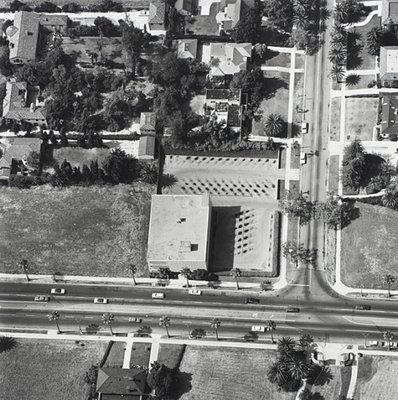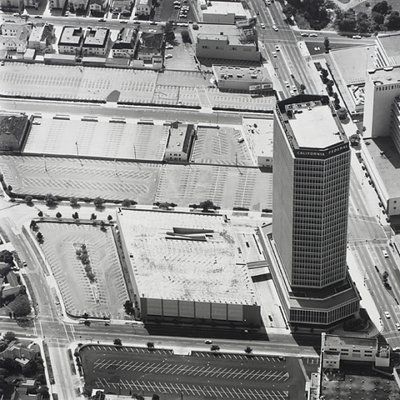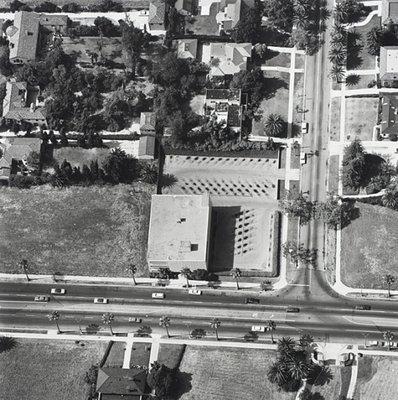More than 100,000 people will fill Wilshire Boulevard this Sunday, June 23, as Angelenos partake in CicLAvia—Iconic Wilshire Boulevard. This car-free event, a celebration of Los Angeles’ public spaces and alternate modes of transportation, invites anyone and everyone to bike, skate, run, or walk the six mile stretch of legendary thoroughfare from Downtown to LACMA. From 9 am till 4 pm participants of all ages will have free range on this typically frenzied road—a principal residential, commercial, commuter, and cultural corridor of our city. You’d expect no less from your favorite neighbors: LACMA will be joining in on the fun.
Named after land developer, entrepreneur, and Socialist, Henry Gaylord Wilshire (1861–1927), Wilshire Boulevard, an exceptionally long and linear street, has taken many forms throughout generations and has, almost inadvertently, become the spine of the city. In one of our newest exhibitions, Presence of the Past: Peter Zumthor Reconsiders LACMA, (and as thoroughly investigated, documented, and displayed by the Page Museum) we learn that centuries ago prehistoric mammals roamed this mineral-dense land. Infamously, the La Brea Tar Pits would become the final resting place for many of these Jurassic denizens. Travel forward through time to the 1880s, and we find a burgeoning Southern California town in the midst of a land boom, where the boulevard’s namesake fatefully purchased a 35-acre tract of land that would eventually be bisected by a 120-foot wide street bearing the family name—the first iteration of Wilshire Boulevard and the creation of a main L.A. artery.
 Parking Lots (Zurich-American Insurance, 4465 Wilshire Blvd.) #15, Edward Ruscha, 1967, Ralph M. Parsons Discretionary Fund
Parking Lots (Zurich-American Insurance, 4465 Wilshire Blvd.) #15, Edward Ruscha, 1967, Ralph M. Parsons Discretionary Fund
With the turn of the century, horse-drawn carriages began sharing this road with steam-driven motor cars and in 1911 the first church, Wilshire Christian Church, popped up on the boulevard. The 1920s welcomed in another boom and residential lots and small office spaces began to sit in the shadows of larger, high-rise apartment buildings and hotels. Soon enough neon signs became a staple of the street and Wilshire Boulevard began to take on its iconic figure. The Depression did not hinder Wilshire Boulevard’s growth to prominence, as the nation’s first fully electric and air-conditioned retail store opened late into the 1930s, alongside other department stores between La Brea and Fairfax Avenues.
Two decades later, building height restrictions were lifted and made way for skyscraper office buildings. Around the same time, the four-level highway interstate exchange (between the 110 and 10 freeways) near Downtown broke ground under Wilshire Boulevard and was deemed one of the country’s largest urban development plans ever. Downtown would thus be nearly vacated for many years to come and Wilshire would become a portal into the west side of town. In a matter of ten years, between the 1960s and 1970s, close to two dozen high-rise office buildings were erected on Wilshire Boulevard.
 Parking Lots (May Company, 6067 Wilshire Blvd.) #25, Edward Ruscha, 1967, Ralph M. Parsons Discretionary Fund
Parking Lots (May Company, 6067 Wilshire Blvd.) #25, Edward Ruscha, 1967, Ralph M. Parsons Discretionary Fund
Into the 1980s plans for the Wilshire subway started to take hold and, mired in a decade’s worth of political controversy spanning municipalities, were cut short, ending the line at Western Avenue. Notably, during the same period, the illustrious Wiltern Theater was purchased by a developer and saved from demolition. This lasting Art Deco building with its relatively small architectural footprint is a type of tower one can only find in Los Angeles. Bringing us into the present, we now see a Wilshire Boulevard that is evolving, however slowly, into a more pedestrian-friendly location. CicLAvia is a way to revel in the history of our public realm and take another step toward shedding our veritable suburban roots.
Join us on Sunday for an excellent day, enjoying quentissential L.A. locales and seeing what and who this city is made of. Visit LACMA for a free Spin Art Studio, free Temporary Tattoo Parlour, free Costume Photo Booth, the sounds of KCRW DJ Dan Wilcox at 1 pm, Andell Family Sundays, and food and drinks from Patina Restaurant Group. Activities begin at 9 am, the museum opens at 10 am.
CicLAvia is a collaboration with the Getty's Pacific Standard Time Presents: Modern Architecture in L.A., a sprawling survey of the postwar built environment of the city.
Roberto Ayala



